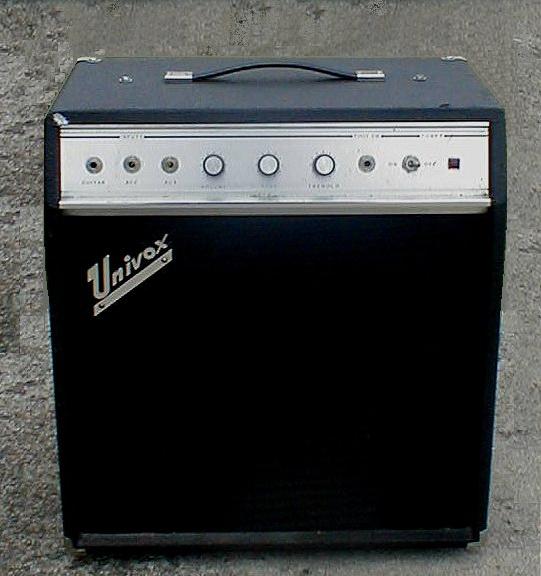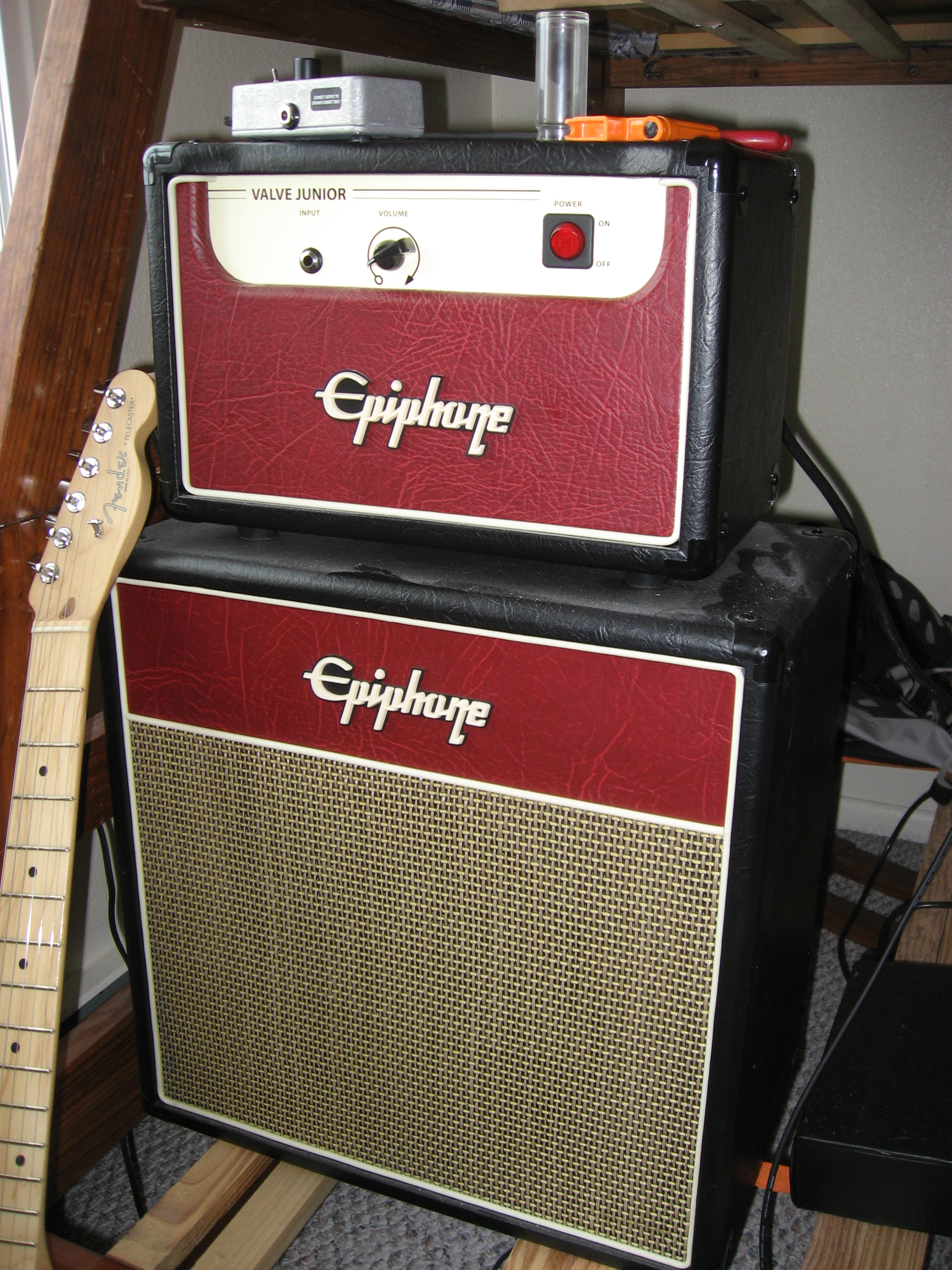|
Univox
Univox was a musical instrument brand of Unicord Corporation from the early 1960s, when they purchased the Amplifier Corporation of America of Westbury, New York and began to market a line of guitar amplifiers. Univox also distributed guitars by Matsumoku, effects units by Shin-Ei Companion, and synthesizers by Crumar and Korg. In 1985, Unicord Corporation was purchased by Korg, and the Univox brand was phased out. History In the early 1960s the Unicord Corporation, a manufacturer of electric transformers, purchased the Amplifier Corporation of America and began marketing a line of amplifiers under the name of Univox. The company was purchased by Gulf+Western in 1967. Univox-branded fretted instruments (electric and acoustic guitars and electric basses) began being imported from Japanese contract manufacturer Matsumoku in 1975, where they continued until 1982, after which instruments were made in Korea under the "Westbury" brand. The Unicord Corporation was purchased by Korg in ... [...More Info...] [...Related Items...] OR: [Wikipedia] [Google] [Baidu] |
Univox Hi-Flier
The Univox Hi-Flier is an electric guitar marketed and sold by Univox (later Unicord) from roughly 1967 to 1977. With its reversed offset body, the Hi-Flier has an intentional resemblance to the Mosrite Ventures model. A bass version of the Hi-Flier was also available. Phases The Hi-Flier went through many changes, generally divided into four "phases." However, the changes that define these have "transitional" periods, where characteristics from an older phase carry over into early production of a new phase. It is impossible to date these guitars by the serial number as it is uncertain whether records were kept on their production. Phase One/Phase One Custom The Hi-Flier model debuted in 1967, with two P-90-style pickups. The design is loosely based on the body shape of the Mosrite Mark 1 and its later iterations, though with a thinner and much lighter body. The top of the Hi-Flier headstock has two "U"-shaped cuts, echoing the three-notch "M" shape of the Mosrite. The pickguard s ... [...More Info...] [...Related Items...] OR: [Wikipedia] [Google] [Baidu] |
Matsumoku
Matsumoku Industrial was a Japanese manufacturing company based in Matsumoto, Nagano, between 1951 and 1987. Established in 1951 as a woodworking and cabinetry firm, Matsumoku is remembered as a manufacturer of guitars and bass guitars, including some Epiphone and Aria guitars. (There is occasional confusion between "Matsumoku" and "Matsumoto". Matsumoto is a town in Japan's Nagano Prefecture, where FujiGen Gakki, Gotoh, and other musical instrument companies have manufacturing plants. Matsumoto Musical Instrument Manufacturers Association is also the name of a musical instrument manufacturing cooperative, headed by Gotoh). History In 1951, Matsumoku was founded as Matsumoto Mokkō ("Matsumoto Woodworking Company") by Mr. Tsukada in Matsumoto, Nagano, Japan. It was a family-owned woodworking business that specialized in building tansu cabinets ometime_between_1946-1951,.html" ;"title="n English: "[Sometime between 1946-1951,">n English: "[Sometime between 1946-1951,' ... [...More Info...] [...Related Items...] OR: [Wikipedia] [Google] [Baidu] |
Effects Unit
An effects unit or effects pedal is an electronic device that alters the sound of a musical instrument or other audio source through audio signal processing. Common effects include distortion/overdrive, often used with electric guitar in electric blues and rock music; dynamic effects such as volume pedals and compressors, which affect loudness; filters such as wah-wah pedals and graphic equalizers, which modify frequency ranges; modulation effects, such as chorus, flangers and phasers; pitch effects such as pitch shifters; and time effects, such as reverb and delay, which create echoing sounds and emulate the sound of different spaces. Most modern effects use solid-state electronics or digital signal processors. Some effects, particularly older ones such as Leslie speakers and spring reverbs, use mechanical components or vacuum tubes. Effects are often used as stompboxes, typically placed on the floor and controlled with footswitches. They may also be buil ... [...More Info...] [...Related Items...] OR: [Wikipedia] [Google] [Baidu] |
Thomas Walter Jennings
Thomas Walter Jennings (28 February 1917 – 1978) was an English businessman who was the founder of Jennings Organ Company. In 1950 he formed Jennings Musical Instruments (JMI) Ltd, the company that produced the famous Vox Guitar amplifiers. In 1956 the company name was changed to Jennings Musical Industries Ltd. Disenchanted with the company direction, he left JMI Ltd in 1967 and set up a separate company, Jennings Electronic Industries. Biography Jennings was born in Hackney, London, England on 28 February 1917. He became an accomplished amateur accordion player. He served with the Royal Electrical and Mechanical Engineers during World War II, but he was discharged from the Army on medical grounds in 1942. Jennings then worked at the Vickers munitions plant in Kent. There he met amateur guitarist Dick Denney who played with a local big band. On occasion, the two played together, but not professionally. Denny also had an interest in electronics and radio technology. In 1 ... [...More Info...] [...Related Items...] OR: [Wikipedia] [Google] [Baidu] |
Korg
, founded as Keio Electronic Laboratories, is a Japanese multinational corporation that manufactures electronic musical instruments, audio processors and guitar pedals, recording equipment, and electronic tuners. Under the Vox brand name, they also manufacture guitar amplifiers and electric guitars. History Korg was founded in 1962 in Tokyo by Tsutomu Kato and Tadashi Osanai as ''Keio Gijutsu Kenkyujo Ltd.''. It later became because its offices were located near the Keio train line in Tokyo and Keio can be formed by combining the first letters of Kato and Osanai. Before founding the company, Kato ran a nightclub. Osanai, a Tokyo University graduate and noted accordionist, regularly performed at Kato's club accompanied by a Wurlitzer Sideman rhythm machine. Dissatisfied with the rhythm machine, Osanai convinced Kato to finance his efforts to build a better one.Julian Colbeck, Keyfax Omnibus Edition, MixBooks, 1996, p. 52. The company's first product was an elect ... [...More Info...] [...Related Items...] OR: [Wikipedia] [Google] [Baidu] |
Privately Held Company
A privately held company (or simply a private company) is a company whose shares and related rights or obligations are not offered for public subscription or publicly negotiated in the respective listed markets, but rather the company's stock is offered, owned, traded, exchanged privately, or Over-the-counter (finance), over-the-counter. In the case of a closed corporation, there are a relatively small number of shareholders or company members. Related terms are closely-held corporation, unquoted company, and unlisted company. Though less visible than their public company, publicly traded counterparts, private companies have major importance in the world's economy. In 2008, the 441 list of largest private non-governmental companies by revenue, largest private companies in the United States accounted for ($1.8 trillion) in revenues and employed 6.2 million people, according to ''Forbes''. In 2005, using a substantially smaller pool size (22.7%) for comparison, the 339 companies on ... [...More Info...] [...Related Items...] OR: [Wikipedia] [Google] [Baidu] |
Gibson Guitar Corporation
Gibson Brands, Inc. (formerly Gibson Guitar Corporation) is an American manufacturer of guitars, other musical instruments, and professional audio equipment from Kalamazoo, Michigan, and now based in Nashville, Tennessee. The company was formerly known as Gibson Guitar Corporation and renamed Gibson Brands, Inc. on June 11, 2013. Orville Gibson started making instruments in 1894 and founded the company in 1902 as the Gibson Mandolin-Guitar Mfg. Co. Ltd. in Kalamazoo, Michigan, to make mandolin-family instruments. Gibson invented archtop guitars by constructing the same type of carved, arched tops used on violins. By the 1930s, the company was also making flattop acoustic guitars, as well as one of the first commercially available hollow-body electric guitars, used and popularized by Charlie Christian. In 1944, Gibson was bought by Chicago Musical Instruments (CMI), which was acquired in 1969 by Panama-based conglomerate Ecuadorian Company Limited (ECL), that changed its ... [...More Info...] [...Related Items...] OR: [Wikipedia] [Google] [Baidu] |
Rickenbacker
Rickenbacker International Corporation is a string instrument manufacturer based in Santa Ana, California. The company is credited as the first known maker of electric guitars – a steel guitar in 1932 – and today produces a range of electric guitars and basses. Rickenbacker twelve-string guitars were favoured by George Harrison of the Beatles, Roger McGuinn of the Byrds, Pete Townshend of the Who, and Tom Petty. Players of the six-string include John Lennon of the Beatles, John Fogerty of Creedence Clearwater Revival, Paul Weller of the Jam, John Kay of Steppenwolf, Peter Buck of R.E.M., Johnny Marr of the Smiths, and Susanna Hoffs of the Bangles. Players who have used Rickenbacker basses include Paul McCartney of the Beatles, Lemmy Kilmister of Motörhead, Cliff Burton of Metallica, Roger Glover and Glenn Hughes of Deep Purple, Chuck Panozzo of Styx, Dougie Thomson of Supertramp, Paul Wilson of Snow Patrol, Bruce Foxton of the Jam, ... [...More Info...] [...Related Items...] OR: [Wikipedia] [Google] [Baidu] |
Ampeg
Ampeg is a manufacturer best known for its bass amplifiers. Originally established in 1946 in Linden, New Jersey by Everett Hull and Stanley Michaels as "Michael-Hull Electronic Labs," today Ampeg is part of the Yamaha Guitar Group. Although specializing in the production of bass amplifiers, Ampeg has previously manufactured guitar amplifiers and pickups and instruments including double basses, bass guitars, and electric guitars. History Early years (1946―1959) Everett Hull (born Charles Everitt Hull), a pianist and bassist from Wisconsin working with bandleader Lawrence Welk in Chicago, had invented a pickup for upright bass in an effort to amplify his instrument with more clarity. Hull's design placed a transducer atop a support peg inside the body of his instrument, inspiring his wife Gertrude to name the invention the "Ampeg," an abbreviated version of "amplified peg." On February 6, 1946, Hull filed a patent application for his "sound amplifying means for string ... [...More Info...] [...Related Items...] OR: [Wikipedia] [Google] [Baidu] |
Epiphone
Epiphone is an American musical instrument brand that traces its roots to a musical instrument manufacturing business founded in 1873 by Anastasios Stathopoulos in Smyrna, Ottoman Empire, and moved to New York City in 1908. After taking over his father's business, Epaminondas Stathopoulos named the company "Epiphone" as a combination of his own nickname "Epi" and the suffix " -phone" (from Greek ''phon-'', "voice") in 1928, the same year it began making guitars. In 1957 Epiphone, Inc. was purchased by Gibson, its main rival in the archtop guitar market at the time. Gibson relocated Epiphone's manufacturing operation from its original Queens, New York, factory to Gibson's Kalamazoo, Michigan, factory. Over time, as Gibson moved its own manufacturing operations to other facilities, Epiphone followed suit; Gibson has also subcontracted the construction of Epiphone products to various facilities in the US and internationally. Today, Epiphone is still used as a brand for the Gibson com ... [...More Info...] [...Related Items...] OR: [Wikipedia] [Google] [Baidu] |
Gulf+Western
Gulf and Western Industries, Inc. (stylized as Gulf+Western) was an American conglomerate. Originally, the company focused on manufacturing and resource extraction. Beginning in 1966, and continuing throughout the 1960s and 1970s, the company purchased a number of entertainment companies, most notably Paramount Pictures in 1966, Desilu Productions in 1967, and a number of record companies, including Dot Records (a subsidiary of Paramount Pictures at the time of purchase) and Stax Records. These became the nuclei of Paramount Television and Paramount Records respectively. The company sold its non-publishing and entertainment assets through the course of the 1980s, with the company re-branding itself as Paramount Communications in 1989. A controlling interest of Paramount Communications was purchased by Viacom in 1994, and the entertainment assets of Gulf and Western are today part of the media conglomerate Paramount Global (also used the Paramount name as the holding com ... [...More Info...] [...Related Items...] OR: [Wikipedia] [Google] [Baidu] |



-2.jpg)
.jpg)


